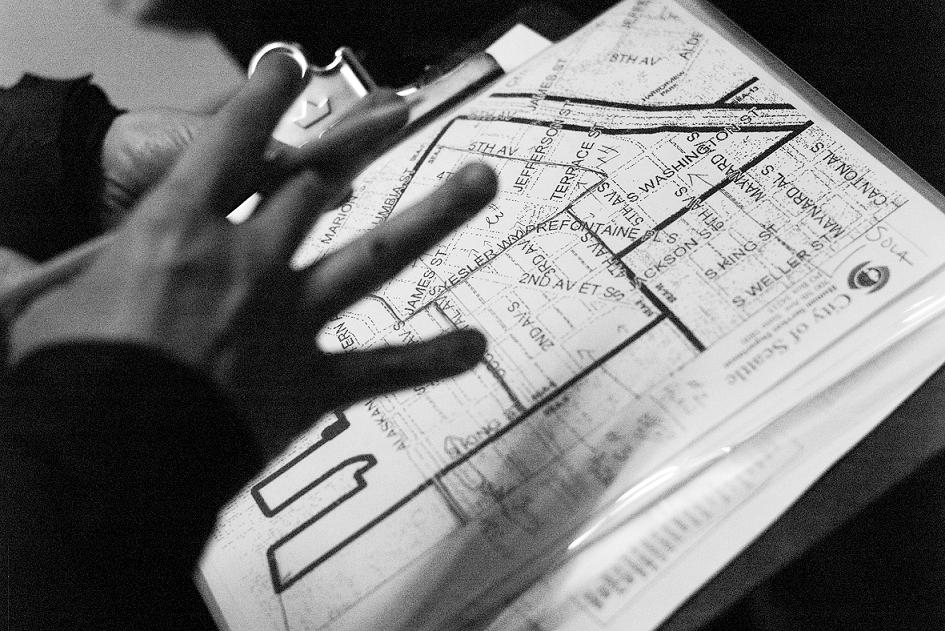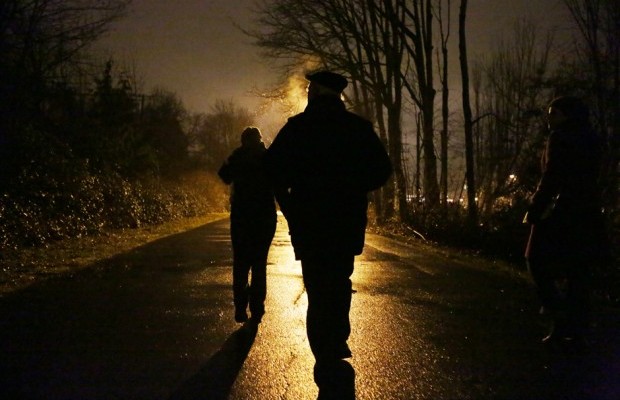Homeless counts will have taken place in every county across the country by the end of January. In this series, “Everyone Counts,” we’ll explore the importance of these counts and hear what impact they had on some of the thousands of volunteers in Western Washington. Today, Perry from Seattle University shares insights from her One Night Count experience and the importance of doing social justice work in community. Volunteering is very important but so is self-care!
By Perry Firth, Grad Project Assistant, Seattle University’s Project on Family Homelessness, Graduate Student, Community Counseling, Seattle University.

It was about 2:30 a.m., and three of us were standing in the kind of drizzle and general sense of wetness that typifies Seattle. We had flashlights, a map, and strict instructions not to disturb anyone we encountered. We were reminded that walking through the wooded areas around Ballard, a neighborhood in northwest Seattle, was in fact the equivalent of walking through people’s bedrooms.
What exactly was I doing there? My group and I were first-time volunteers participating in King County’s One Night Count (Seattle/King County Coalition on Homelessness), an annual event whose goal is to determine the number of homeless people sleeping outside or in their cars or other unsuitable shelter, as well as those in shelters or transitional housing. The count is an essential tool for understanding trends in homelessness and for affordable housing advocacy.
Before beginning our search, our team leader, Graham, gave us basic instructions. We weren’t supposed to shine our flashlights directly into cars, or over sleeping people. The reasoning was simple; no one wants to wake up to a bright light shining in their face. Whispers were recommended and cell phones were turned off. As we set off, Graham re-emphasized that this was a group activity; any volunteer that took it upon themselves to wander off on their own needed to be promptly called back.
Why I was there
Listening to our instructions, I reflected on what had brought me, someone who dislikes going to bed past 11:30 p.m., into a dark parking lot at 2:30 a.m. The easy answer to this would be that my recent decision to accept a job on the Project on Family Homelessness had funneled my social justice passions towards homelessness advocacy. More importantly, I had been told that if I wanted to bridge the gap between writing about homelessness and actually doing something, then I needed to participate in the count.
On another level, my presence there was a natural extension of my own passion for working with marginalized groups of people. In the past, this has taken the form of my commitment to working with women who have experienced sexual assault, as well as my ongoing volunteering as phone worker at the Crisis Line of King County.
I had prepared for the evening with the knowledge that getting caught up in my own emotional reactions to homelessness is counter-productive, and even selfish. Ruminating on how badly you feel about something doesn’t actually fix the problem, and can often prevent meaningful action.

My time at the Crisis Line had also taught me that there is an important line that needs to be drawn. On one side of this line there is you, and your reactions to the suffering you see around you. On the other side of the line there is the person you hope to help, or the inequality you hope to right. You have to keep the focus on the people you want to help, without getting caught up in yourself. At the same time, you need to remember to engage in self care.
Not knowing what to expect and keeping an open mind, I set out with my group.
What motivates other volunteers
As we walked, I wondered what inspired my fellow volunteers to give their time to the One Night Count. I knew why I was there, but what was motivating them? If volunteering the hours they usually devoted to sleeping was an expression of their ongoing dedication to ending homelessness, how did they do it without becoming overwhelmed? What kind of support enables someone to dedicate countless hours to this kind of work?
Making our way to the wooded area where we were to begin searching in earnest, I asked Jennie, a woman in my group, variations of these questions. Did any of my experiences resonate with her?

Jennie told me her passion for working with the homeless began when she realized how lucky she has been throughout her life. This realization stemmed from her understanding that having a home to return to is an easily forgotten gift. She has harnessed this gratitude, using it to fuel her commitment for working with homeless men and women.
I asked her what kind of emotions direct service work brought up for her, and what that meant for her continuing ability to work with people who are homeless. She brought up the importance of boundaries.
To illustrate her point, she described how she used to make and serve food to people who are homeless from her home.
At this time, she was also doing many other things to help people experiencing homelessness. She soon found herself becoming worn out, highly stressed from seeing so many in need, troubled by her inability to contribute her efforts in the fight to end homelessness without burning out. She knew she could not continue like this on her own.
Avoiding volunteer burnout
Feeling that her experience is indicative of the “burnout” faced by many people in the helping profession, I asked Jennie how she had learned to manage the emotions that can be part of working with people who are often invisible or misunderstood by the general population.
Her answer was clear and confident. You can’t do this kind of work alone. You need the emotional support that comes from sharing efforts among a group of like-minded people. You need them to tell you to take a break. You need them to help you remember that every person helped, every person who eventually benefits from activities like the One Night Count, is worth the effort put into what can sometimes feel like an uphill battle.
Like many advocates working for overlooked populations, she keeps the faith by maintaining a dedicated focus on the people she has helped, rather than getting lost in the many still without resources. Progress is made one person at a time.
At this point we made our way into the trees, our boots sinking into decaying leaves, our legs and bodies brushing trees and twigs as we began to look for people who called the muddy ground their home. As we walked, I felt twinges of fear born from my lifelong aversion to walking in wooded areas in the dark. I felt this apprehension in spite of the fact that I was with three other people.
If I was feeling vaguely fearful, many people who have at some point slept beneath the trees have felt the same thing to a far greater degree. I was struck by the injustice our society imposes on people who are homeless. The very thing people need to find relief from the uncertainties and harsh realities of the world, a safe, warm home, is the very thing that is denied those who are homeless.
What we found
That evening we did not find anyone curled up beneath the trees. Instead, our meandering way through the woods was littered by recently abandoned campsites. Garbage here, an old tarp there. Ground flattened by absent sleeping bodies.
Our efforts led us to three cars, all clearly lived in. With their windows steamed up, and coverings on the inside for privacy, you could tell that their inhabitants were doing the best they could with what they had to work with. As it turned out, the people sleeping in those cars were the only ones we counted the entire evening.
Up until about 4:30 a.m., I had done a surprisingly good job of staying awake and motivated. However, on the walk back to our car, fatigue hit me hard. I started to dwell on my cozy apartment, my comfortable bed, the hours of secure sleep I would soon be returning to. It was in that moment, as my eyelids started to get heavy, that I remembered information given to us on our training sheet. Many people who do not have shelter will walk the entire night through. I would soon be in bed sleeping; they would continue to walk.
Would I recommend this experience to future volunteers? Yes.
Above and beyond being a necessary tool for determining the number of people without a home, it is a valuable experience for anyone interested in social justice. It takes something intangible, the awareness that being without a home is hard, and makes it concrete (walking all night in the rain is hard, really hard).
See you next year?